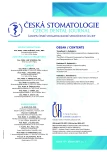The Effect of Chemical Compounds on Pigmentation and Depigmentation of Teeth (Review article)
Authors:
V. Tomečková; S. Dolinská
Authors‘ workplace:
Ústav lekárskej a klinickej biochémie LF UPJŠ, Košice, Slovenská republika
Published in:
Česká stomatologie / Praktické zubní lékařství, ročník 117, 2017, 1, s. 3-7
Category:
Original articles
Overview
Introduction, aim: The aim of this review is to describe the composition and biochemical importance of pellicle – organic layer at the teeth surface during effect of external environment, different chemical elements and compounds (in fruit, vegetables, food, drink, tobacco), psychotropic agents, on the enamel colour, structure and the oral cavity health. This paper discusses the possible biochemical mechanisms involved in the binding of different pigments – chromogens to the pellicle of the teeth enamel. Natural and synthetic substances from the diet may have coloring or bleaching effect on the teeth enamel.
Methods:
A comparison of the various chemicals effects from diet on the teeth pigmentation.
Results:
Explanation of effect of the natural as well as synthetic pigments on the enamel color. Pigments present in tobacco, coffee, wine, carrot and blueberry juices, as well as the excessive use of some chemical elements such as iron, chlorine can adversely change the enamel colour. The chromogen binds to the pellicle of the teeth disposed on the surface or penetrate deeper into the enamel layers. The natural pigments are mainly carotenoids (orange and yellow), flavonoids (purple), chlorophyll (green) which are components in certain fruits, vegetables and a variety of drinks e.g. juices and others that are prepared of the mentioned sources. On the other hand, some foods containing ascorbic acid (apple, tangerine, orange and others) and bromelain (pineapple) have a whitening effect on the teeth, as the result of increased salivation and organic acids content.
Conclusion:
Organic and chemical components from the environment, food, coming into contact with tooth enamel pellicle and influence the health and colour of teeth either positively or negatively. Natural dyes – chromogens: flavonoids, carotenoids, chlorophylls present in liquids and foodstuffs, as well as synthetic drugs and various chemical elements can be fixed to the various surfaces of pellicle, but also in the inner layers of the enamel and change the color or teeth. Choosing appropriate foods containing ascorbic acid and bromelain can whiten teeth. Some foods, however, on the one hand whiten teeth but on the other hand, with their increased consumption can cause enamel erosion and irreversible damage of the enamel structure. The citrus fruits have these whitening properties as the result of the high content of organic acids, therefore it is important to consume them balanced way.
Keywords:
enamel – pellicle – pigments – coloration
Sources
1. Jugdaohsingh, R., Pedro, L. D., Watson, A., Powell, J. J.: Silicon and boron differ in their localization and loading in bone. Research. Bone Rep., 2015 z https://www.ncbi.nlm.nih.gov/pub-med/26665155
2. Kala, K., Muszynska, B., Zajac, M., Krezalek, R., Opoka, W.: Determination of zinc(II) ions released into artificial digestive juices from culinary-medicinal button mushroom, Agaricus bisporus (Agaricomycetidae), biomass of in vitro cultures using an anodic stripping voltammetry method. A longitudinal study. Int. J. Med. Mushrooms., roč. 18, 2016, č. 2, s. 155–164.
3. Kumar, A., Kumar, V., Singh, J., Hooda, A., Dutta, S.: Drug-induced discoloration of teeth. Review. Clin. Pediatr., roč. 52, 2011, č. 2, s. 181–185.
4. Lee, J., Lambert, D., Prabhu, S., et al.: Delivery of the polyphenols to the oral cavity by grren tea leaves and black tea extract. Research support. Cancer Epidemiol. Biomarkers Prev., roč. 13, 2004, č. 1, s. 132–137.
5. Liu, Y.: The relationship between lifestyle and self – reported oral health among American adults. Review. Int. Dent. J., roč. 64, 2014, č. 1, s. 46–51.
6. Nakonieczna-Rudnicka, M., Bachanek, T., Madejczyki, M., Grajewskai, I., Kobyłecka, E.: Teeth whitening versus the in-fluence of extrinsic factors on teeth stains. Review. Przegl. Lek., roč. 72, 2015, č. 3, s. 126–130.
7. Rajesh, S., Hegde, S., Kumar, S.: Assessment of salivary calcium, phosphate, magnesium, pH, and flow rate in healthy subjects, periodontitis, and dental caries. A longitudinal story. Contemp Clin Dent., roč. 6, 2015, č. 4, s. 461–465.
8. Sampath, K. P.: Dental anatomy and tooth morphology. St. Luise, Elsevier, 2004, 144 s. ISBN 978-0723606666.
9. Soeters, P., Reijevem, L., Bokhorst, V., van der Schueren, A., Schols, M., Halfens, J., Meijers, M., van Gumert, G.: A rational approach to nutritional assesment. Research support. Clin. Nutr., roč. 27, 2008, č. 5, s. 706–716.
10. Stejskalová, J., et al.: Konzervační zubní lékařství. Praha, Galén, 2008, 235 s. ISBN 9788072625406 235.
11. Xu, L., Loos, G., Craandijk, J., Ritsema, E., Huffels, A., van der Velden, U.: Teeth with periodontal bone loss, cigarette smoking and plasma cotinine levels. Research support. J. Int. Acad. Periodontol., roč 4, 2002, č. 2, s. 39–43.
Labels
Maxillofacial surgery Orthodontics Dental medicineArticle was published in
Czech Dental Journal

2017 Issue 1
Most read in this issue
- Biochemical Composition of the Teeth and the Effect of the Various Chemical Elements on their Structure (Review article)
- The Effect of Chemical Compounds on Pigmentation and Depigmentation of Teeth (Review article)
-
Review of the Expert Systems in General Medicine and Dentistry
(Review Article) - The Roma Population and Selected Aspects of Dental Care (Original Article – Epidemiologic Study)
